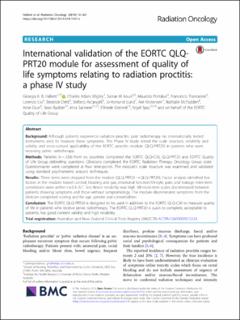| dc.contributor.author | Halkett, Georgia K.B. | |
| dc.contributor.author | Wigley, Charles Adam | |
| dc.contributor.author | Aoun, Samar M. | |
| dc.contributor.author | Portaluri, Maurizio | |
| dc.contributor.author | Tramacere, Francesco | |
| dc.contributor.author | Livi, Lorenzo | |
| dc.contributor.author | Detti, Beatrice | |
| dc.contributor.author | Arcangeli, Stefano | |
| dc.contributor.author | Lund, Jo-Åsmund | |
| dc.contributor.author | Kristensen, Are Korsnes | |
| dc.contributor.author | McFadden, Nathalie | |
| dc.contributor.author | Grun, Arne | |
| dc.contributor.author | Bydder, Sean | |
| dc.contributor.author | Sackerer, Irina | |
| dc.contributor.author | Greimel, Elfriede | |
| dc.contributor.author | Spry, Nigel | |
| dc.date.accessioned | 2023-01-09T14:53:07Z | |
| dc.date.available | 2023-01-09T14:53:07Z | |
| dc.date.created | 2019-01-14T15:43:40Z | |
| dc.date.issued | 2018 | |
| dc.identifier.citation | Radiation Oncology. 2018, 13 (162), 1-10. | en_US |
| dc.identifier.issn | 1748-717X | |
| dc.identifier.uri | https://hdl.handle.net/11250/3042069 | |
| dc.description.abstract | Background - Although patients experience radiation proctitis post radiotherapy no internationally tested instruments exist to measure these symptoms. This Phase IV study tested the scale structure, reliability and validity and cross-cultural applicability of the EORTC proctitis module (QLQ-PRT23) in patients who were receiving pelvic radiotherapy.
Methods - Patients (n = 358) from six countries completed the EORTC QLQ-C30, QLQ-PRT23 and EORTC Quality of Life Group debriefing questions. Clinicians completed the EORTC Radiation Therapy Oncology Group scale. Questionnaires were completed at four time-points. The module’s scale structure was examined and validated using standard psychometric analysis techniques.
Results - Three items were dropped from the module (QLQ-PRT23 → QLQ-PRT20). Factor analysis identified five factors in the module: bowel control; bloating and gas; emotional function/lifestyle; pain; and leakage. Inter-item correlations were within r = 0.3–0.7. Test-Retest reliability was high. All multi-item scales discriminated between patients showing symptoms and those without symptomology. The module discriminated symptoms from the clinician completed scoring and for age, gender and comorbidities.
Conclusion - The EORTC QLQ-PRT20 is designed to be used in addition to the EORTC QLQ-C30 to measure quality of life in patients who receive pelvic radiotherapy. The EORTC QLQ-PRT20 is quick to complete, acceptable to patients, has good content validity and high reliability. | en_US |
| dc.language.iso | eng | en_US |
| dc.publisher | BioMed Central Ltd. | en_US |
| dc.rights | Navngivelse 4.0 Internasjonal | * |
| dc.rights.uri | http://creativecommons.org/licenses/by/4.0/deed.no | * |
| dc.title | International validation of the EORTC QLQ-PRT20 module for assessment of quality of life symptoms relating to radiation proctitis: a phase IV study. | en_US |
| dc.type | Peer reviewed | en_US |
| dc.type | Journal article | en_US |
| dc.description.version | publishedVersion | en_US |
| dc.source.pagenumber | 1-10 | en_US |
| dc.source.volume | 13 | en_US |
| dc.source.journal | Radiation Oncology | en_US |
| dc.source.issue | 162 | en_US |
| dc.identifier.doi | 10.1186/s13014-018-1107-x | |
| dc.identifier.cristin | 1656566 | |
| cristin.ispublished | true | |
| cristin.fulltext | original | |
| cristin.qualitycode | 1 | |

